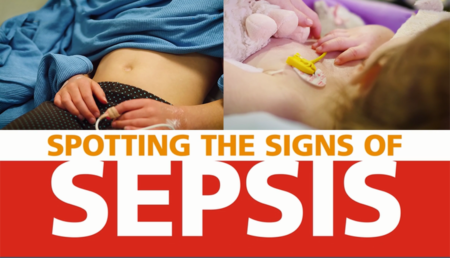Spotting the Signs of Sepsis: Emergency Department
Spotting the Signs of Sepsis Safe Discharge Video: Digital Pack

This digital pack has been designed for use by clinicians within Paediatric Emergency Departments (EDs)
The Health Innovation Network (HIN) has worked in partnership with NHS England and the ASK SNIFF Safety Netting Collaborative to produce the “Spotting the Signs of Sepsis” video.
The clinical content is based on the Public Health England parental awareness campaign materials that were developed in collaboration with the UK Sepsis Trust and launched in December 2016.
The video is designed to standardise the safety netting advice clinicians provide for parents of children under five with fever or suspected infection being discharged home from the Emergency Department (ED). It is unique in not only informing parents of what signs and symptoms they should be looking out for at home whilst their child is unwell but also showing real life examples of these, as well as providing practical tips on caring for their child with fever at home.
Sepsis in children is fortunately rare, but is a disease entity that has the potential to develop over time and therefore it can be expected that there will be occasions when a clinician appropriately sends home a child who subsequently develops sepsis. It is therefore vital in these situations for parents to feel empowered with the knowledge and confidence to recognise concerning signs of serious illness in their child and act on their instincts to seek medical attention again, as early recognition and treatment of sepsis is known to improve outcomes.
A study by the RCPCH, published in 2010, showed that only 81% of parents contacting urgent and emergency care services for their child with fever received, or remembered, any safety netting advice. Parents who received this information were less likely to contact medical services again in that illness. In the ED setting only 45% of parents received advice on what to look for at home. The importance of providing safety netting advice to parents at risk of sepsis being discharged home was also highlighted in the NCEPOD report “Just Say Sepsis”.
The video will also be publically available on the NHS Choices website to raise awareness of the presenting features of sepsis in children under five. This complements the written material already present on the website and will enable parents who watched the video in the ED to refresh their memories by watching again at home. Primary care clinicians will also be able to signpost parents to watch the video online as part of their safety netting practice.
This file can be downloaded and saved to a desktop within your Emergency Department. Clinicians can then easily start the video for parents using the link from the desktop and leave the parents to watch the video whilst they complete their documentation.
Non-English language versions of the video are being developed and will sent out to EDs shortly to ensure as many parents as possible can benefit from the information contained within the video.
(coming soon)
You may already have your own departmental safety netting leaflet for parents, but we have included here (link) the leaflet developed by the UK Sepsis Trust that accompanies the video content that you may wish to you. You can download and print this locally to supplement the information clinicians provide verbally within the ED setting and that is contained within the video. It also contains the links to the video on the NHS Choices website to allow parents to watch again at home.
We have designed a poster that you may wish to display in your ED to prompt clinicians to consider the safety netting advice they provide to parents as part of a safe discharge process.
Everyone watch
Show the video to the clinicians working in your ED so that they are familiar with its content. This will ensure that they are aware of the advice that is being recommended to parents to ensure a consistent message is spread. In parents who have represented this may help clarify the nature of the concerns that have prompted this repeat ED visit.
Dedicated space
Find a quiet space for parents to watch the video that is out of the way of the main activity within your department. This will allow them to concentrate on watching the video and ensure that they are not in the way of other clinicians and parents/patients.
Supplement with a leaflet
We recommend continuing to provide parents with a written safety netting leaflet. This is good practice as parents will not remember all the information clinicians have provided verbally or within the video. Ensure the link to the NHS Choices website is provided for parents so that they can easily access, and watch again, the video at home.
Documentation
Encourage clinicians to document in the patient’s notes when the parents have watched the video and any additional advice provided, to demonstrate that safety netting advice has been provided.
We believe this is the first video that incorporates real-life footage of children with signs of sepsis to educate parents on what to be looking out for at home. We are therefore keen to evaluate its impact and potential for future uses.
Please ask parents who have watched the video on your ED to complete our short survey (link – ?different for each site) to provide feedback on their experience of the video. The last section of this survey will ask parents if they are happy to provide contact details for a member of the HIN team to call them in 4-6 weeks’ time to find out how they have used the information that was provided.
We are also interested in hearing your views on how you, and other clinicians, found using the video to supplement verbal safety netting advice and any impact it has had on your clinical work. A member of our team will be in contact with your ED to discuss how best to coordinate this clinician feedback.